
Path leading up to the entrance of the colonial monastery in Izamal, Mexico
Browse 820+ izamal stock photos and images available, or search for mexico izamal or izamal mexico to find more great stock photos and pictures.

Path leading up to the entrance of the colonial monastery in Izamal, Mexico
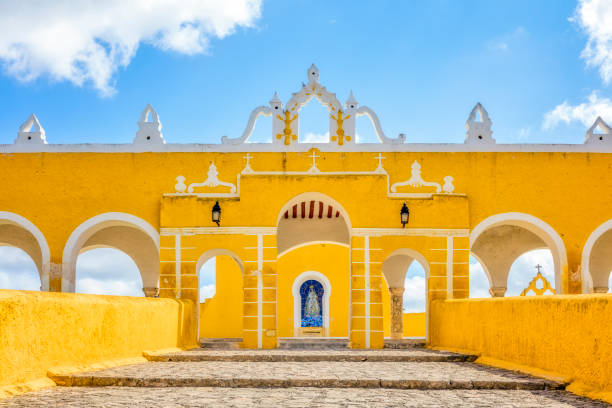
Izamal, Yucatan, Mexico, known as “The Yellow City”, is a major Mayan archeological site and home of Bishop Diego Landa, who burned most pre-columbian Mayan codices. The conqueror’s city is built over the ruins. In 1549, a Franciscan monastery was built on the platform of the main pre-Hispanic pyramid. The relatively small town at the time of the conquest was greatly expanded in the middle of the 16th century by the resettlement of the scattered population of the surrounding area, which lived for some time in politically divided districts. In Izamal, auxiliary troops of the Spaniards from central Mexico settled in a small settlement called La Concepción, which kept their native language for several decades.

Izamal, Mexico. Yellow colonial town in Yucatan Peninsula, Central America.

Izamal yellow town Mexico, colonial monastery of San Antonio in Yucatan

Izamal, Mexico. Spanish colonial Yellow City, Convento de San Antonio in Yucatan Peninsula
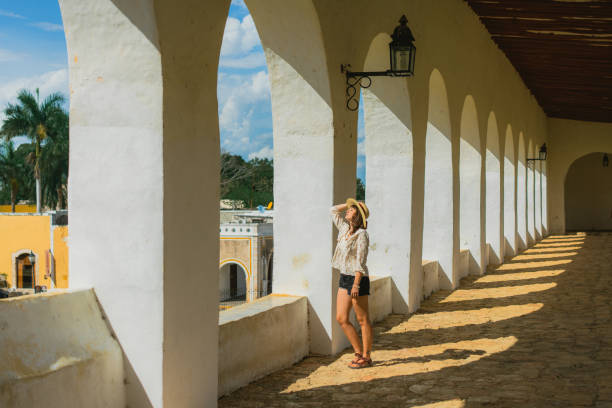
Young Caucasian woman walking among columns in yellow Izamal town in Mexico
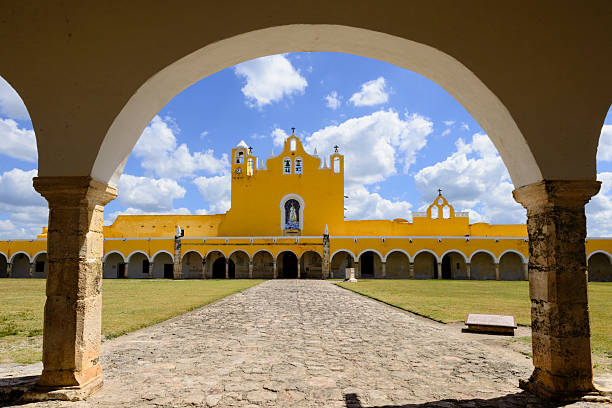
Convent in the city of Izamal, Yucatan, Mexico. The city is sometimes referred to as the Yellow City since many of the buildings are colored yellow. The main attraction is the Convento de San Antonio de Padua located at the town center. It was built upon the ruins of a pre-columbian Mayan building.

Izamal, Mexico. Convent of Saint Anthony of Padua.

Izamal, Yucatan, Mexico, known as “The Yellow City”, is a major Mayan archeological site and home of Bishop Diego Landa, who burned most pre-columbian Mayan codices. The conqueror’s city is built over the ruins. In 1549, a Franciscan monastery was built on the platform of the main pre-Hispanic pyramid. The relatively small town at the time of the conquest was greatly expanded in the middle of the 16th century by the resettlement of the scattered population of the surrounding area, which lived for some time in politically divided districts. In Izamal, auxiliary troops of the Spaniards from central Mexico settled in a small settlement called La Concepción, which kept their native language for several decades.

Young Caucasian woman in straw hat walking in yellow Izamal town in Mexico, Yucatan

View of the convent from Plaza Izamal, Izamal, Yucatan, Mexico

Izamal, Mexico - July 28, 2018 : Horse pulled wagon moves in a yellow street with a row of motorcycles at the left and local stores under the arches, at Izamal

Young Caucasian woman in straw hat walking in yellow Izamal town in Mexico, Yucatan

Scenic view of yellow town Izamal in Mexico, Yucatan

Izamal, Mexico - March 4, 2014: Colorful horsedrawn carriages waiting for riders in the town square. The Franciscan Monastery can be seen in the background.

A quiet day in a yellow town. Izamal, known as the “Yellow City” in Yucatán, is home to Convento de San Antonio de Padua, an old convent built in 1549 on the top of a Mayan pyramid which the Spanish conquistadors leveled into a terrace. Almost every building in the town is painted in shades of yellow.

Scenic view of yellow town Izamal in Mexico, Yucatan
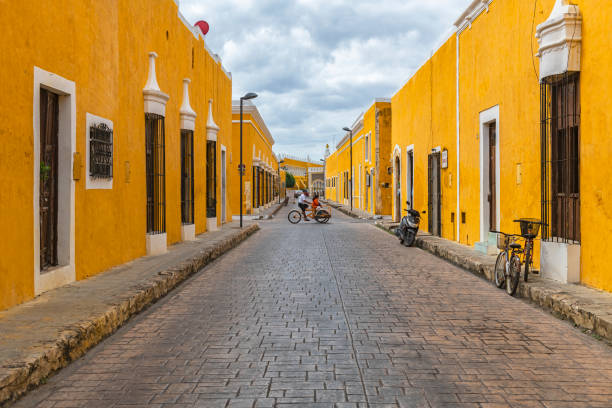
Cityscape with people on a Tricycle in the colorful yellow streets with colonial style architecture, Izamal, Mexico.

The colorful yellow arches of the Franciscan Convent in Izamal near Merida and Cancun, Yucatan Peninsula, Mexico.

San Antonio de Padua convent architecture, Izamal, Yucatan, Mexico.

Capilla de la Santa ;cruz is one of the oldest buildings in the city o Izamal. The chapel like the other buildings in the city, are painted in yellow.

Young mexican woman on a bicycle with blur motion in the yellow city of Izamal with arch architecture by the main square, Yucatan Peninsula, Mexico.

Izamal, Mexico. Convent of Saint Anthony of Padua and horse carriages.

Izamal is a small little village in the Yucatan peninsula of Mexico. It is known for its staggering beauty- most of the buildings in the village are painted yellow.

Young Caucasian woman in straw hat walking in yellow Izamal town in Mexico, Yucatan

The beautiful colonial city of Izamal in the Yucatan state of Mexico

Entryway to Izamal's Church. Izamal is located in Yucatan, Mexico and is considered a magical town.

Izamal, Mexico - July 28, 2018 : View of San Antonio of Padua Convent from Izamal from Plaza Izamal at Izamal, Yucatan, Mexico

Izamal, Mexico - April 7, 2020: Mexican tricycle cab driver with passenger driving through the streets of the yellow city Izamal with its colonial style architecture.

Izamal, Yucatan, Mexico, known as “The Yellow City”, is a major Mayan archeological site and home of Bishop Diego Landa, who burned most pre-columbian Mayan codices. The conqueror’s city is built over the ruins. In 1549, a Franciscan monastery was built on the platform of the main pre-Hispanic pyramid. The relatively small town at the time of the conquest was greatly expanded in the middle of the 16th century by the resettlement of the scattered population of the surrounding area, which lived for some time in politically divided districts. In Izamal, auxiliary troops of the Spaniards from central Mexico settled in a small settlement called La Concepción, which kept their native language for several decades.

The horse-drawn carriage infront of the facade of the church, Convento De San Antonio. The yellow city of Izamal, Yucatan, Mexico

Izamal, Mexico - July 28, 2018 : View of San Antonio of Padua Convent at Izamal from Plaza Izamal at Izamal, Yucatan, Mexico

Panoramic of the convent in the city of Izamal, Yucatan, Mexico. The city is sometimes referred to as the Yellow City since many of the buildings are colored yellow. The main attraction is the Convento de San Antonio de Padua located at the town center. It was built upon the ruins of a pre-columbian Mayan building.

San Antonio de Padua convent at sunset, Izamal, Yucatan, Mexico.

great pyramid to the Maya Sun God, Kinich Kak in the city of Izamal,Yucatan,Mexico
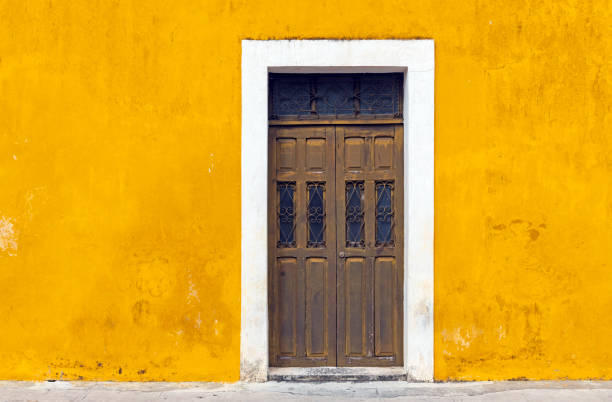
Yellow wall facade and door in the city center of Izamal, Yucatan Peninsula, Mexico.
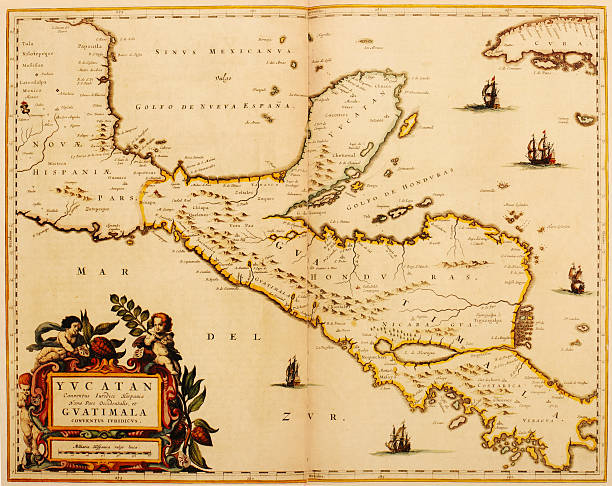
Antique map of Central AMerica covering nowadays Guatemala, Belize, Honduras and Costa RicJapa. Published by the Dutch cartographer Willem Blaeu in Atlas Novus (Amsterdam 1635). Photo by N. Staykov (2007)

Mexico, Merida architecture line skyline illustration. Linear vector cityscape with famous landmarks, city sights, design icons. Landscape wtih editable strokes

Izamal, Yucatan, Mexico, 23th of May 2017, A cityscape of Izamal with yellow architecture. Editorial only.

Young Caucasian woman in straw hat walking in yellow Izamal town in Mexico, Yucatan

Izamal, Yucatan. Spanish colonial Yellow City, Convento de San Antonio in Mexico, Central America.

Bar Sign at a historic house in Mexico.

Crafts of hammocks souvenir of Izamal

Great Mayan Pyramid of Kukulkan, known as El Castillo, classified as Structure 5B18, taken in the archaeological area of Chichen Itza, between trees and sky, in the Yucatan peninsula

Convent in the city of Izamal, Yucatan, Mexico. The city is sometimes referred to as the Yellow City since many of the buildings are colored yellow. The main attraction is the Convento de San Antonio de Padua located at the town center. It was built upon the ruins of a pre-columbian Mayan building.

Great Mayan Pyramid of Kukulkan, known as El Castillo, classified as Structure 5B18, taken in the archaeological area of Chichen Itza, in the Yucatan peninsula
© 2024 iStockphoto LP. The iStock design is a trademark of iStockphoto LP. Browse millions of high-quality stock photos, illustrations, and videos.
Do Not Sell or Share